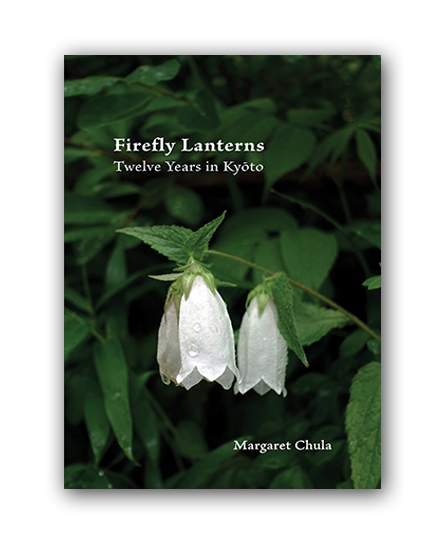Firefly Lanterns: Twelve Years in Kyōto by Margaret Chula
Shanti Arts Publishing, 2021, 138 pages, 24 full-color images, $24.95
ISBN: 978-1-951651-98-5 (print; softcover; perfect bound)
For a signed copy and free shipping, please order directly from the author at [email protected].
I have known Maggie for almost thirty years, having met shortly after her return from living in Japan. I found several of the stories in Firefly Lanterns to be familiar tales she shared while we visited beneath the copper beech in her back meadow in Portland or shared a meal. Other stories were new to me, and even the ones I had heard before took on new life because of her decision to write them as haibun. This Japanese form began as a type of travel writing, making it particularly appropriate for sharing Chula’s memories of her time abroad. It combines prose paragraphs with haiku, allowing the poet to craft detailed vignettes punctuated with crystalized images in the haiku. Chula is a longtime practitioner of haibun and even invented the form of linked haibun with Rich Youmans in their book Shadow Lines. In Firefly Lanterns, she takes varied approaches, sometimes concluding the haibun with haiku and other times interspersing haiku throughout a longer prose narrative.
The book is beautifully produced and contains twenty-four full-color original photographs and drawings that enhance the details of the haibun. It also contains many Japanese words that simply don’t translate accurately into English, and there is a glossary at the back for readers unfamiliar with these terms.
A major strength of this collection is Chula’s ability to select key experiences out of the many options she had to choose from over her twelve-year stay in Kyoto. She shares what is most meaningful to her and also what will give the reader the truest insight into her time in Japan. Rather than acquiescing to nostalgia, she strives for accuracy, providing precise details that create highly evocative renderings of her experiences. For instance, in the title haibun, she describes visiting her friends in Ayabe, which is a roughly two-and-a-half-hour drive from Kyoto. The fireflies are out, and everyone is outside at night catching them:
Tomoko plucks a bellflower for me and explains that hotaru means firefly and bukuro is
sack. With our butterfly nets, we scoop the air and capture a net full of fireflies. Carefully
we transfer them to the hotaru bukuro by opening the blossoms and inserting the fireflies
into their petal-soft cage. Soon the flowers begin to take on the glow of the fireflies’
light….
After returning to the house, they release the fireflies into the room:
lying on tatami / in a room full of fireflies / the evening cool
In the darkened room, we drink sake and talk softly, speak of gentle things, the
importance of friendship, the natural abundance of life….
When it’s finally time to retire, Murayama-san opens the shoji and releases the fireflies
into the night. By morning they will have scattered far and wide, specks of darkness
against the overcast sky.
An additional accomplishment is Chula’s skill at drawing the reader into the unfamiliar, crafting present-tense descriptions that make the reader feel they are sharing her experiences and feelings in real time rather than in the past.
Yet another impressive element of this collection is Chula’s decision to construct the book in two parts. The first focuses on her life in Kyoto during the 1980s. The second part describes the return trip she took with her husband in 1997. After immersing the reader in her Japanese life, this second part skillfully conveys Chula’s feelings when encountering the many changes and losses that have occurred after only five years away. Readers, too, will find themselves emotionally impacted by these changes.
One of the most heartfelt sections of the book is its final series of haibun focusing on Chula’s ikebana sensei (flower arrangement teacher), with whom she studied for the entire twelve years she lived in Japan. On returning to Kyoto, Chula learns that Sensei has Alzheimer’s and visits her in the Alzheimer’s Home only to realize that her teacher has no memory. It is a poignant conclusion to a collection that preserves Chula’s memories of her life in Japan and the changes that occur there once she leaves. Chula’s memories of Sensei and of Kyoto will not be lost as the student returns to Oregon and carries on the tradition of the teacher: clipping camellias /with Sensei’s old scissors /a new year begins.
In many ways, this collection is like Sensei’s scissors: a haibun master at the height of her ability preserving stories of her time in Japan and modeling the many approaches to the haibun form for others to follow. Don’t miss this master at work. Firefly Lanterns is a wonderful collection I highly recommend.
Reviewer Bio:
Ce Rosenow’s books and chapbooks include The Backs of Angels, Even If, North Lake, Pacific, A Year Longer, and Spectral Forms. She is one of the eight authors of Beyond Within: A Collection of Rengay, and co-editor of The Next One Thousand Years, The Selected Poems of Cid Corman with Bob Arnold. She co-authored Care Ethics and Poetry with Maurice Hamington, and her book Lenard D. Moore and African American Haiku: Merging Traditions is forthcoming from Lexington Books. She is also the former President of the Haiku Society of America.

